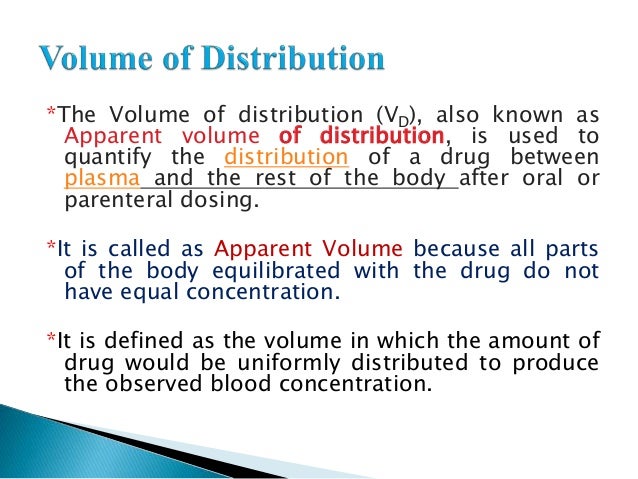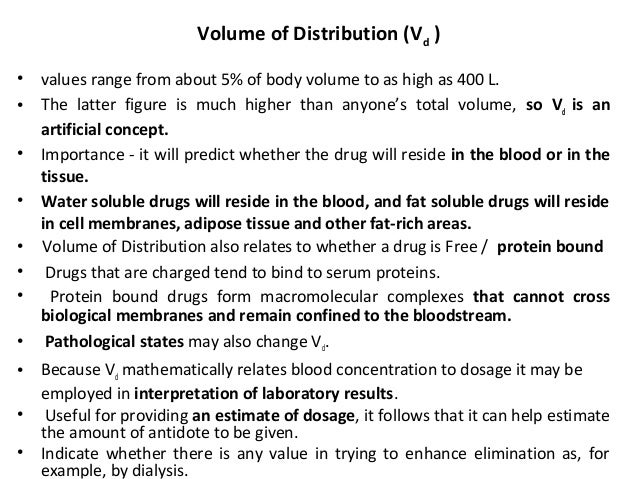Tho it is NOT true, try to think of Vd simply reflects the volume of drugs dispersed into body tissues.
However, in fact, grams of drugs/Vd = grams of drugs/plasma volume = plasma concentration
Therefore => Vd = grams of drugs/plasma concentration
=> Vd = is a proportionality factor, not a physiologic factor (2)
=> The amount of solution/solvent a drug needs to dissolved into to reach similar concentration of its concentration in plasma
Why does it matter? We need to know the Vd in order to calculate the desired loading dose (grams or mg) so that we can have the DESIRED drug concentration in the plasma.
What Vd is really, like really? "The volume of distribution is the theoretical size of the compartment necessary to account for the total drug amount in the body if it were present throughout the body in the same concentration found in the plasma." (1)
Sooo weird, like you have to know Vd to calculate the necessary dosage, then why how could the pharmacist figure out the Vd? They do that empirically I suspect by calculating the plasma concentration and the dosage given and then keep an index of these #'s (3) (after Wonder Me! googled a lot with key words such as how pharmacists calculate necessary volume of distribution, it linked me to a NAPLEX book. So helpful!)
Clinical examples:
- Digoxin must get into myocardial tissue with several compartments, what do you think its Vd wold be? Massive! (lots to get into tissue-binding)
- Warfarin must stay in the blood (think: blood thinner! must stay in the blood to 'thin' blood!) => therefore it has a small loading dose (think: you don't want to give too much of a drug directly to the blood stream when it likes to stay in the blood and doesn't want to go anywhere else. Meaning it doesn't need to that much to get to be highly-concentrated in the blood!) => Needless to say it has a small Vd.
- Understanding Vd will help you get the desired Loading dose correctly!
- (4):
| Drug | VD | |
|---|---|---|
| Warfarin | 8L Reflects a high degree of plasma protein binding. | |
| Theophylline, Ethanol | 30L Represents distribution in total body water. | |
| Chloroquine | 15000L Shows highly lipophilic molecules which sequester into total body fat. | |
| NXY-059 | 8L Highly charged hydrophilic molecule. |
Blurb:
- Vd simply reflects the volume of drugs dispersed into body tissues. (NOT true)
- High protein-bound (think Albumin in blood, think circulation and plasma, think big huge protein-drug complex unable to cross blood stream to leak into intracellular or interstitial fluid) drugs => Low Vd
- High tissue-bound drugs => high Vd
- High Vd => low plasma concentration
- Low Vd => high plasma concentration
This means the higher Vd, the higher the amount of drugs binding to body tissues and lower the amount of drugs 'swimming' freely in the blood plasma.
This means the small Vd will have a high initial concentration as the drug just enters the plasma content but then it will become smaller in concentration.
This means that the large Vd will have a low concentration (all drugs dispersed into the tissues).
Helpful interactive site to illustrate this concept: http://www.icp.org.nz/icp_t3.html
~Wonder Me
Citation:
(1) http://www.nebraskamed.com/app_files/pdf/careers/education-programs/asp/pk_trainingpacket_2012.pdf)






No comments:
Post a Comment